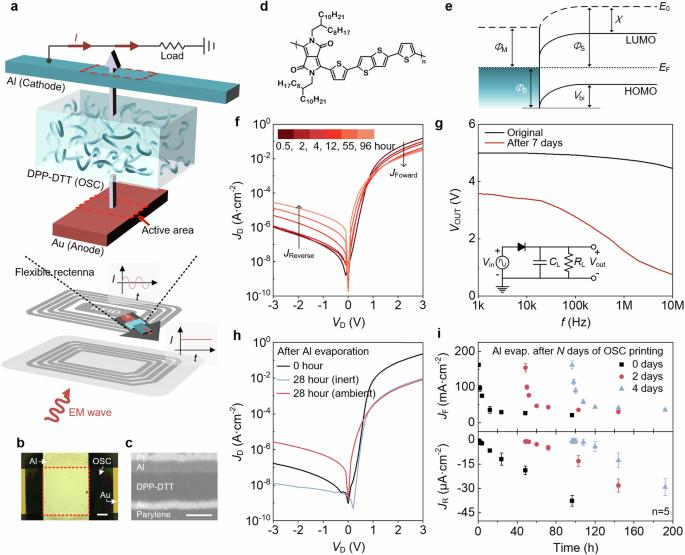Stabilizing Schottky junction in conjugated polymer diodes enables long-term reliable radio-frequency energy harvesting on plastic
IF 12.3
1区 材料科学
Q1 ENGINEERING, ELECTRICAL & ELECTRONIC
引用次数: 0
Abstract
Due to their inherent flexibility, solution-processable conjugated polymers are increasingly being considered for the cost-effective production of thin-film semiconductor devices used in Internet of Everything (IoE) applications. With considerable improvements in charge carrier mobilities, the final challenge impeding the commercialization of conjugated polymers may be improving their environmental and electrical stabilities. Recent studies have improved the stability of computing devices (i.e., transistors) by eliminating interface traps and water molecules within conjugated polymers. However, the stability issue of Schottky diodes, which play a crucial role in configuring thin-film IoE devices used in wireless communication and energy harvesting, has been largely overlooked. This study reveals that aluminum, which is commonly used as a cathode metal in polymer Schottky diodes, creates a nonstoichiometric effect when deposited on conjugated polymers, thereby leading to the formation of charge traps over time, which reduces the rectification ratio of the Schottky diodes and induces a significant bias stress effect during operation. To address this issue, we introduce a zinc-oxide sacrificial interlayer between the conjugated polymer and cathode. This interlayer effectively eliminates the penetrated Al metal or ionized Al-induced nonstoichiometric effect without reducing the charge injection efficiency, achieving exceptional environmental and operational stability. The printed polymer Schottky diodes demonstrate consistent rectifying operation at 13.56 MHz for several months with negligible changes in electrical characteristics.

稳定共轭聚合物二极管中的肖特基结,在塑料上实现长期可靠的射频能量采集
可溶液加工的共轭聚合物因其固有的灵活性,正越来越多地被考虑用于万物互联(IoE)应用中薄膜半导体器件的低成本生产。随着电荷载流子迁移率的大幅提高,阻碍共轭聚合物商业化的最后一个挑战可能是提高其环境和电气稳定性。最近的研究通过消除共轭聚合物中的界面陷阱和水分子,提高了计算设备(即晶体管)的稳定性。然而,肖特基二极管的稳定性问题却在很大程度上被忽视了,而肖特基二极管在配置用于无线通信和能量收集的薄膜物联网设备方面发挥着至关重要的作用。本研究发现,铝通常用作聚合物肖特基二极管的阴极金属,当沉积在共轭聚合物上时,会产生非均衡效应,从而导致电荷陷阱的长期形成,降低了肖特基二极管的整流比,并在工作期间诱发显著的偏压效应。为了解决这个问题,我们在共轭聚合物和阴极之间引入了氧化锌牺牲中间层。该中间层可有效消除穿透铝金属或电离铝引起的非均衡效应,同时不会降低电荷注入效率,从而实现优异的环境和运行稳定性。印刷聚合物肖特基二极管在 13.56 MHz 频率下可持续整流运行数月,电气特性的变化可忽略不计。
本文章由计算机程序翻译,如有差异,请以英文原文为准。
求助全文
约1分钟内获得全文
求助全文
来源期刊

npj Flexible Electronics
Multiple-
CiteScore
17.10
自引率
4.80%
发文量
91
审稿时长
6 weeks
期刊介绍:
npj Flexible Electronics is an online-only and open access journal, which publishes high-quality papers related to flexible electronic systems, including plastic electronics and emerging materials, new device design and fabrication technologies, and applications.
 求助内容:
求助内容: 应助结果提醒方式:
应助结果提醒方式:


